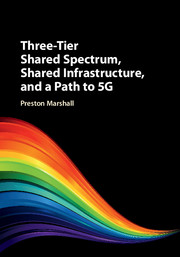Book contents
- Frontmatter
- Contents
- Acknowledgments
- Preface
- Part I Spectrum Sharing Background
- 1 Introduction to Three-Tier Spectrum Sharing
- 2 Prior Dynamic Spectrum-Sharing Regimes
- Part II Three-Tier Dynamic Spectrum Models
- Part III Components of a Three-Tier Architecture
- Part IV Protection Processes for Incumbents and Peers
- Part V Example Use of Three-Tier Spectrum: Use of the 3.5 GHz CBRS Band in the USA
- Part VI Future Bands, Network Services, Business Models, and Technology
- Part VII Appendices
- Index
- References
2 - Prior Dynamic Spectrum-Sharing Regimes
from Part I - Spectrum Sharing Background
Published online by Cambridge University Press: 30 August 2017
- Frontmatter
- Contents
- Acknowledgments
- Preface
- Part I Spectrum Sharing Background
- 1 Introduction to Three-Tier Spectrum Sharing
- 2 Prior Dynamic Spectrum-Sharing Regimes
- Part II Three-Tier Dynamic Spectrum Models
- Part III Components of a Three-Tier Architecture
- Part IV Protection Processes for Incumbents and Peers
- Part V Example Use of Three-Tier Spectrum: Use of the 3.5 GHz CBRS Band in the USA
- Part VI Future Bands, Network Services, Business Models, and Technology
- Part VII Appendices
- Index
- References
Summary
Introduction
This chapter discusses traditional exclusive licensing of spectrum, and some of the current proposals that have emerged recently to address spectrum access shortfalls and to address the improved utilization of underused spectrum. In general, these approaches address many of the same weaknesses in the spectrum models that were discussed in the last chapter. In this chapter, we will compare each of these approaches to the five principles developed and justified in Chapter 1, Table 1.1.
This chapter will also discuss how each of the spectrum sharing models influenced the development of the three-tier model. Each of these existing models contributed experience that was central to the refinement of the principles of the three-tier model. While many commentators consider the three-tier model as a radical departure from current practices, it was, in fact, a somewhat evolutionary response to experience with the models described in this chapter.
Exclusive-Usage Models
Traditionally, spectrum has had to be licensed for a single usage, or a single user. There are a number of works that provide the details of this method of spectrum management, and these details will not be included in this chapter, except as required to develop the concept of three-tier spectrum regimes. This discussion is thus very simplistic, and admittedly skips over many subtle aspects of traditional spectrum management.
The spectrum that is considered for three-tier implementation is generally assigned and managed in one of these two methods, which are significant from the perspective of how this regime can be instantiated.
Exclusive Usage Exclusive usage licensing dedicates spectrum to a single purpose; broadcasting, satellite uplink or downlink, radars, etc. Users are licensed to use this band for the exclusive purpose, but have no exclusivity, in that any other user can use the spectrum for the same purpose. Traditionally, it has been hard for other uses to share this spectrum, since all of the systems deployed in it were developed on the assumption that all of the uses would be identical. In most cases, this spectrum does not cost the user any significant payments, and only requires some form of registration and perhaps coordination with other pre-existing users. The fact that this spectrum was provided by the public without significant cost makes such spectrum more (politically) available for introduction of new sharing regimes.
Information
- Type
- Chapter
- Information
- Publisher: Cambridge University PressPrint publication year: 2017
